Recent Articles
Popular Makes
Body Types
10 Best Features of the 2023 Toyota Prius Prime
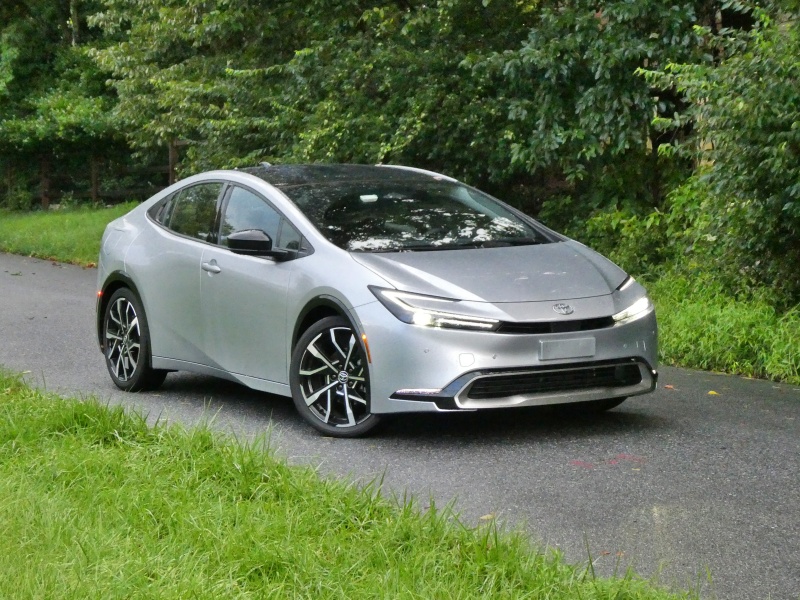
Photo by Brady Holt
Electric cars are all the rage. But for many buyers, it’s tough to accept the limitations of charging them. When an EV runs out of juice, you need to find a place to charge it up, and even the fastest ones need a lot more time than filling up a tank of gas.
Fortunately, there’s a middle ground between gasoline and electric. And one of the most popular choices just got better than ever. That’s the newly redesigned 2023 Toyota Prius Prime, a plug-in hybrid electric vehicle (or PHEV). With a PHEV, you still charge it up with electricity, but a gasoline engine is standing by in case you need to drive farther. We just spent a week testing the 2023 Prius Prime, a compact hatchback that’s priced from $32,350. Here are the 10 best things about this new plug-in hybrid.
Greatly Improved Range
Last year’s Prius Prime traveled an EPA-estimated 25 miles per charge. That’s enough to cut your gasoline bill, but many owners would still need to use some gas every day.
The redesigned Prius Prime goes much farther on a charge. The base SE model manages an EPA-estimated 44 miles before needing its gasoline model, and even the uplevel XSE and XSE Premium can go an estimated 39 miles. And unlike some PHEVs, it can even accelerate pretty quickly and travel at speeds up to 84 mph without needing help from its gasoline engine. Our XSE Premium test vehicle beat its EPA estimate to travel 43.5 miles in a mix of highway, rural, and suburban driving, including 1.1 miles via an unconventional charging source that we’ll discuss momentarily. Recharging a Prius Prime takes four hours on a 240-volt car charger or 11 hours on a regular 120-volt household outlet. So even without specialized equipment, you can plug in when you get home from work, and it should be fully charged up again when you set off the next day.
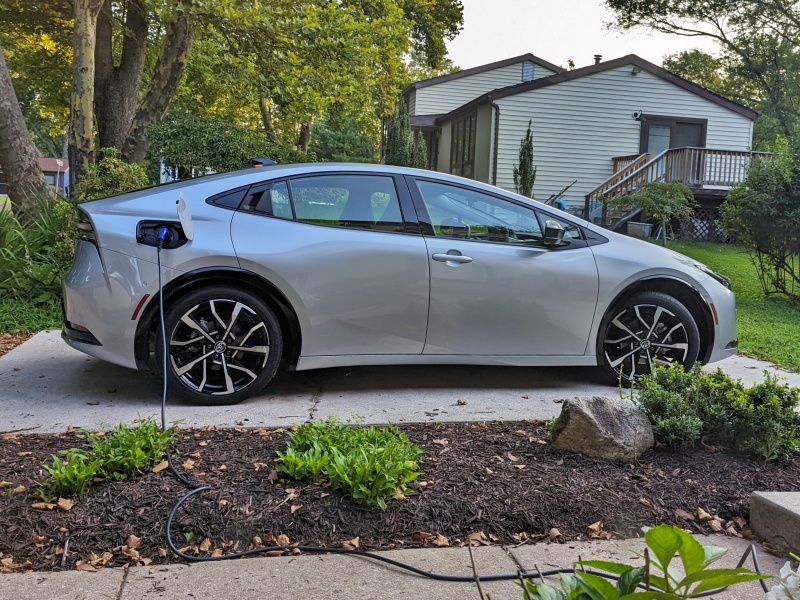
Photo by Brady Holt
Help From a Solar Roof
Our test vehicle included an optional 185-watt solar roof, which helps charge the battery when you’ve parked in the sun and helps power auxiliary functions while you’re driving.
This may sound like a gimmick versus putting solar panels on your house, but if you’re out and about away from a plug, it’s a way to extend your range. We parked the Prius Prime for a couple of hours at the county fair, and that was enough to give it an extra 1.1 miles of range. Since we were going to surpass our electric range to get back home to a plug, that was 1.1 miles that we didn’t need to use gasoline. In total, our Prius Prime test vehicle reported running for 140 miles on self-generated solar power during its 4,000-mile life to date, which would come to 3,500 solar miles out of every 100,000. That’s not a big savings considering how little the Prius Prime costs to operate already, but it’s a nifty plus to an eco-friendly vehicle, especially if you’ll park frequently in full sun.
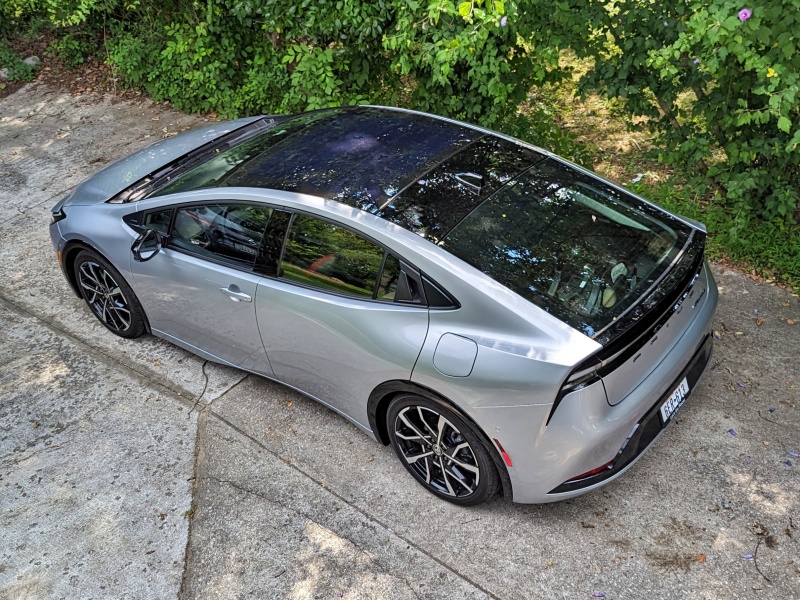
Photo by Brady Holt
Excellent Hybrid Mileage, Too
Many PHEVs are luxury cars that get mediocre gas mileage after their all-electric range is gone. Instead, a Prius Prime minus its all-electric range is a Prius: one of the most fuel-efficient cars in the U.S.
In EPA testing, the Prius Prime SE gets 53 mpg in the city, 51 mpg on the highway, and 52 mpg combined, while other models get 50 mpg city, 47 mpg highway, and 48 mpg combined. We averaged about 51 mpg in our XSE Premium test vehicle without factoring in our plug-in range. So the Prius Prime can avoid burning any gasoline for all or most of your commute, then sip it until you’re able to charge up again.
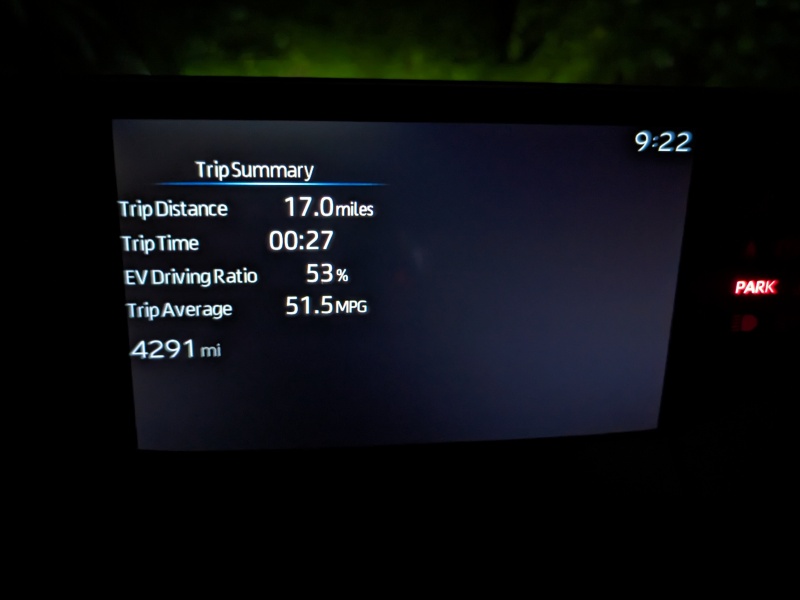
Photo by Brady Holt
Sporty New Styling
Last year’s Prius Prime was widely considered the best-looking Prius version, with more conventional headlights and taillights than the extra-out-there hybrid model. This year, Toyota converged them into one acclaimed design that has won praise from folks who’d never have considered a Prius before.
This new model is lower and wider, and its details are simplified. The headlights became crisp C-shapes that merge into a small grille. The hood flows smoothly into the windshield, good news for both style and aerodynamics. The smaller side windows, hidden rear doorhandles, and rear lightbar further give the Prius the stance of a luxury sports coupe. It’s sleek, upscale, sporty, and downright beautiful. To spot a Prius Prime, watch for white taillamps instead of the standard hybrid’s red. There’s also a charging port on the passenger-side rear fender (across from the gas tank) and a small “Prime” badge on the liftgate.
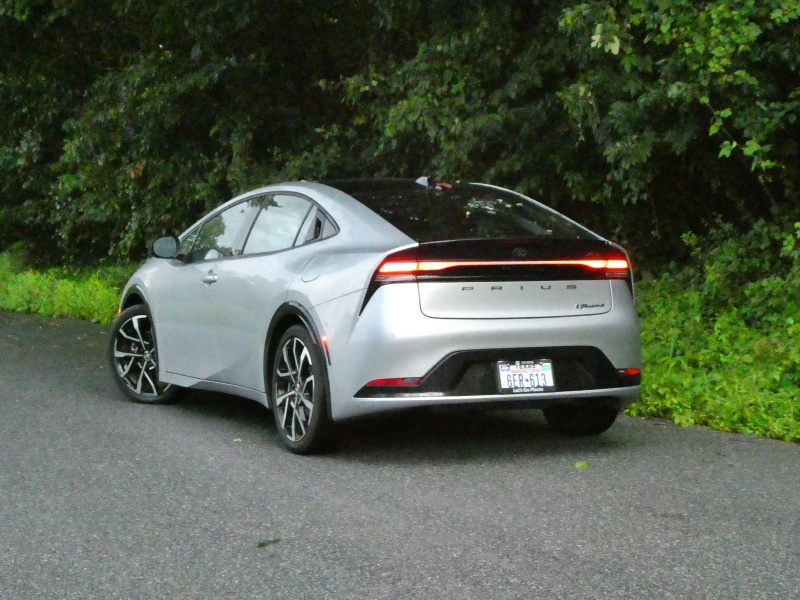
Photo by Brady Holt
Speedier Performance to Match It
The Prius Prime doesn’t merely look sporty. Its new powertrain, while still incredibly efficient, also delivers much livelier performance than before.
The 2023 Toyota Prius Prime now makes 220 horsepower from a combination of a 2.0-liter four-cylinder gasoline engine and an electric motor. That’s pretty strong for a small car, and it should zip the Prius Prime to 60 mph in less than 7 seconds. You won’t find gleefully insane speed like in a Tesla, but the new Prius Prime no longer feels sluggish and strained like its 121-hp predecessor. You wouldn’t buy a Prius Prime because you’re looking for a fast car, but acceleration is at least no longer a reason for most folks to stay away. The Prime is also slightly quicker than the standard 2023 Prius, which makes 196 hp.
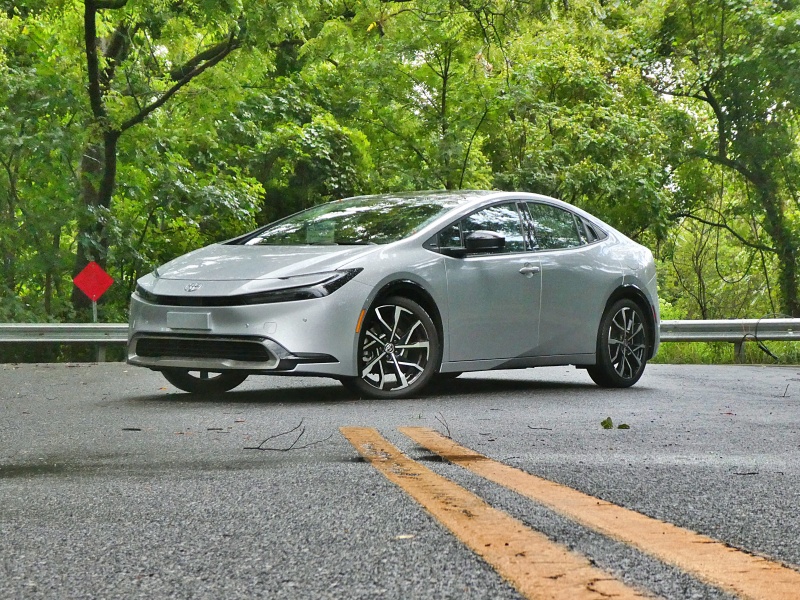
Photo by Brady Holt
Good Ride and Handling
Toyota had already improved the Prius’s ride and handling in its previous redesign, even if it didn’t catch many enthusiasts’ attention while the car was still so slow. But the 2023 Prius Prime has become more responsive than ever.
The Prius Prime has responsive, natural-feeling steering that’s light and easy at low speeds without feeling loose and disconnected when you’re moving faster. A steady, composed suspension and a lower center of gravity make it feel more expensive than before, if not really sports-car crisp. Especially when paired with the quieter, less strained acceleration, it’s clear you’re no longer driving just a cheap hatchback when you set off in a Prius Prime. And like a Tesla, you can unlock and start certain Prius Primes using your smartphone, what Toyota calls a digital key.
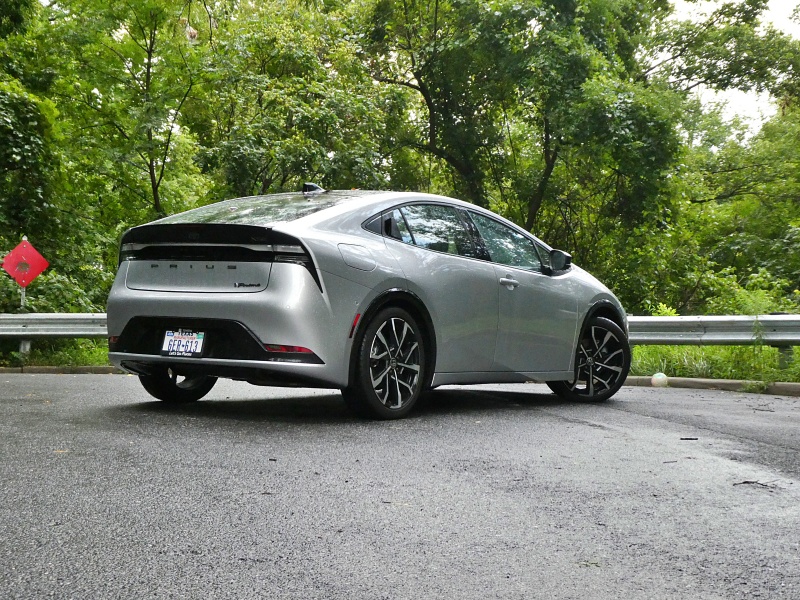
Photo by Brady Holt
Modernized Interior
The 2023 Toyota Prius Prime has a modern new interior with a more conventional design and materials. The digital gauge cluster now sits in front of the driver rather than off to the side. And the new dashboard reversed most automakers’ trend by adding more physical buttons and knobs rather than taking them away. These controls complement the standard 8-inch infotainment touchscreen or the 12.3-inch unit found on upper-level models like our test vehicle.
Toyota did still give the cabin a bit of weirdness. In a design shared with the bZ4x electric SUV, the Prius Prime’s speedometer is positioned to be seen over the steering wheel rim rather than under it. But overall, it’s less quirky and more richly finished than before. Our chief complaint is that Toyota could have done more with its big infotainment screen, which makes you swap among various views rather than presenting more info simultaneously. We like watching efficiency-related displays in hybrids, but Toyota hides radio or navigation information if you try that in the Prius Prime.
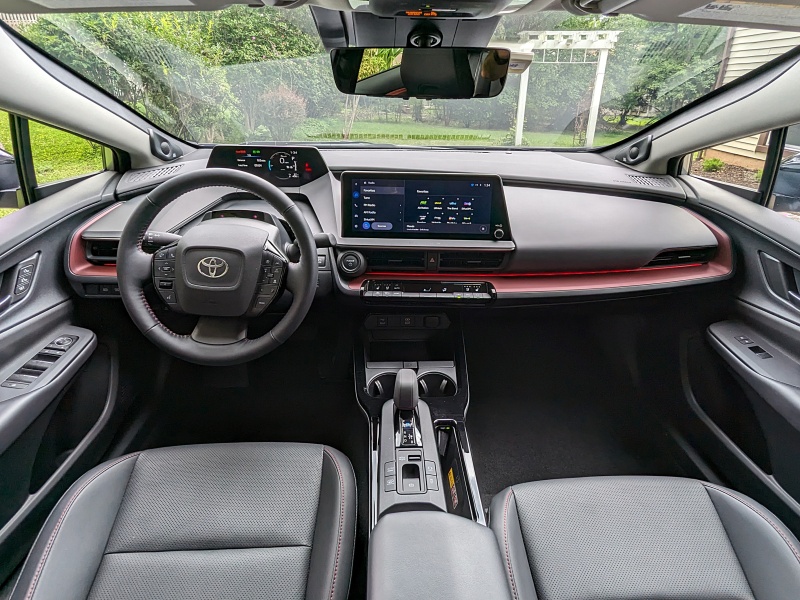
Photo by Brady Holt
Hatchback Versatility
It’s easy to focus on the Prius’s efficiency. But another of its longtime selling points has been its functionality as a roomy five-door hatchback.
The redesigned 2023 Toyota Prius Prime demands some tradeoffs for its sleek shape. The backseat has less headroom and legroom than before, so Uber passengers will be squished. They’ll also have to hunt for the back doors’ hidden exterior handles. Still, the Prius Prime has comfortable front seating, while better battery positioning improves its cargo capacity to 20.3 cubic feet. That’s the same as the non-PHEV Prius. And even if it’s not the world’s roomiest hatchback, 20.3 cubic feet is significantly bigger than just about any modern sedan’s trunk. Plus, you can dold down the Prius Prime’s backseat to create a bigger open cargo hold. The Kia Niro PHEV has more total cargo space, a higher seating position, and a bigger backseat, and it only costs about $1,000 more than the Prius Prime. But its all-electric range peaks at 33 miles.
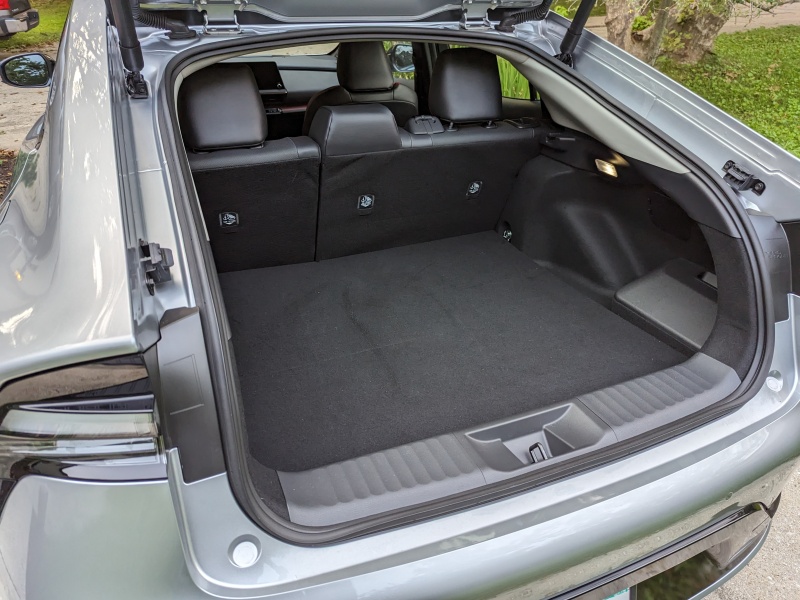
Photo by Brady Holt
Lots of Standard Safety Features
Toyota has been a leader in standard safety features in recent years, and the 2023 Prius Prime continues that trend. It comes standard with many advanced technologies that cost extra even on many luxury cars.
Every Prius Prime includes a forward-collision warning with automatic emergency braking, the ability to recognize pedestrians and cyclists, blind-spot monitoring with a rear cross-traffic alert, a lane-departure warning with lane-keeping and lane-tracing steering assistance, and adaptive cruise control. Other welcome add-ons include a digital rearview mirror that eliminates rear blind spots, a surround-view parking camera that even renders a see-through view of the ground under the car, and reverse automatic braking.
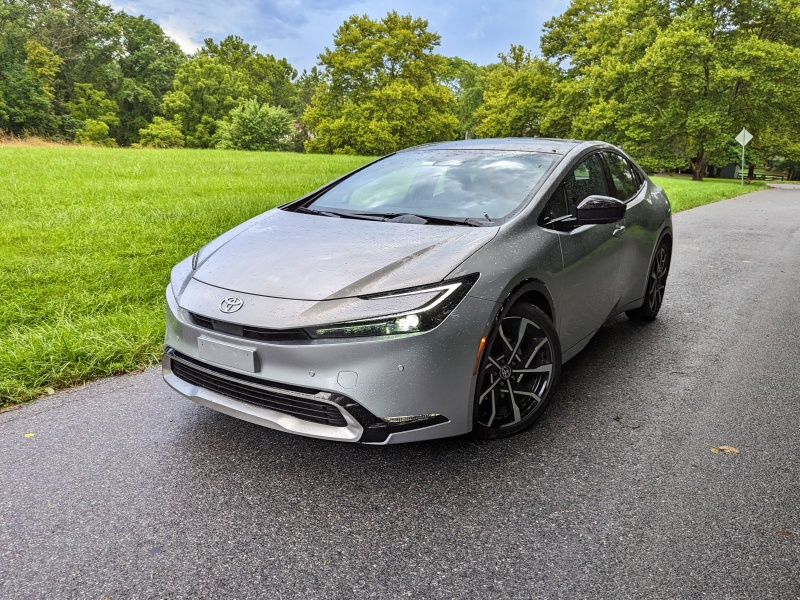
Photo by Brady Holt
Still the Cheapest PHEV on the Market
Despite its many excellent points, the 2023 Toyota Prius Prime has the lowest sticker price of any PHEV in the U.S. It opens at $32,350 for the SE version, which is well-equipped with the safety features we mentioned plus automatic climate control, a heated steering wheel, rain-sensing windshield wipers,17-inch alloy wheels, and push-button starting. The XSE, $35,600, adds leatherette upholstery, a power driver’s seat, heated front seats, 19-inch wheels, and rear automatic braking. The XSE Premium, like our test vehicle, rises to $39,170 with ventilated front seats, a premium JBL stereo, a power liftgate, and several XSE options: the bigger touchscreen, GPS navigation, a sunroof, and the digital key system. And our test vehicle topped $40,000 with options that include the solar roof, heated rear seats, the rearview camera mirror, and the surround-view parking camera.
These prices aren’t ultra-cheap for a compact hatchback. But consider the Prius’s slick looks, long list of features, and 220-horsepower powertrain, and it can get some attention even before you get to the main selling point: Many people will rarely or never need to gas it up.
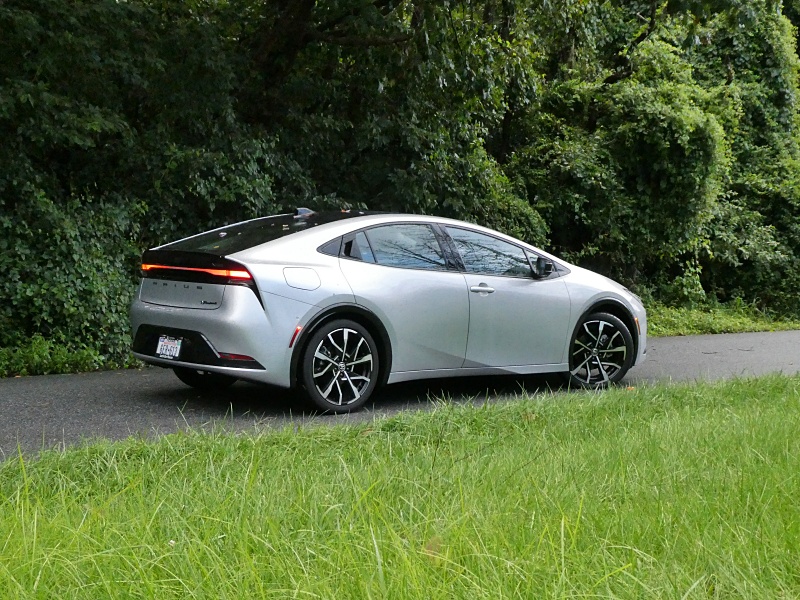
Photo by Brady Holt